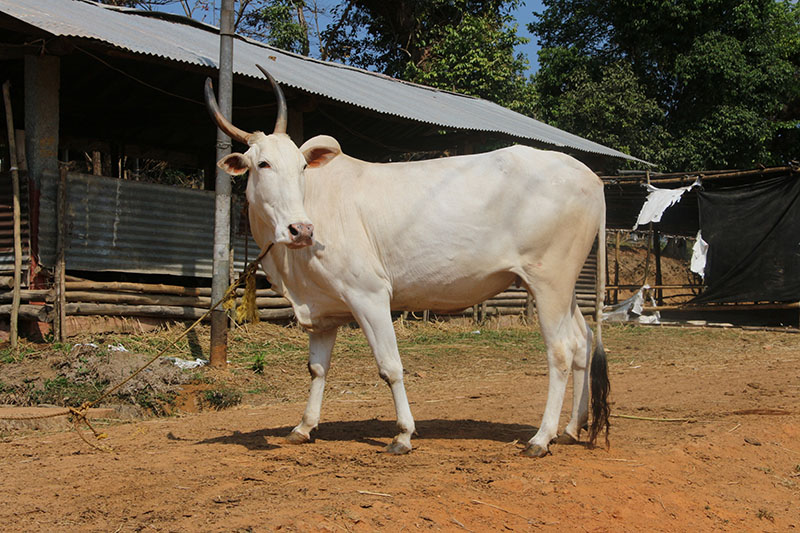Khillari Cattle
There is every reason to believe that the  Khillari breed, with its several varieties, owes its origin to the Hillikar breed
of cattle from Mysore State. Unlike some of the other breeds of cattle in India, it
does not take its name from a geographical area. Khillar means a herd of cattle, while
Khillari means belonging to Khillar; hence the herdsman is known as Khillari; in the
Satpura range of hills, he is known as Thillari. There is a special tribe of professional
cattle breeders in this region known as Thillaris.
Khillari breed, with its several varieties, owes its origin to the Hillikar breed
of cattle from Mysore State. Unlike some of the other breeds of cattle in India, it
does not take its name from a geographical area. Khillar means a herd of cattle, while
Khillari means belonging to Khillar; hence the herdsman is known as Khillari; in the
Satpura range of hills, he is known as Thillari. There is a special tribe of professional
cattle breeders in this region known as Thillaris.
There are four principal types of Khillaris prevalent in the different regions of Bombay State. The variety Hanam Khillar, or sometimes known as Atpadi Mahal (the word Mahal shows strong similarity of cattle of Mysore State), is prevalent in the southern Mahratta States of Bombay. In the districts of Sholapur and Satara and the adjoining areas the variety known as Mhaswad Khillari is prevalent. In the area of the Satpura range of hills comprising the West Khandesh district the variety prevalent is known as Tapi Khillari or Thillari. A variety of more recent origin known as Nakali Khillari - Nakali means "imitation" - is found in adjacent areas of these regions.
In the southern Mahratta States and the districts of Sholapur and Satara the Khillaris are bred by cultivators. In these regions the size of the herd is small, usually not more than one or two cows. In the Satpura ranges the Khillaris are bred by professional breeders known as Thillaris. These breeders produce bulls and bullocks for which there is always a very good demand. Besides their extensive use in their home tracts they are used in the adjacent districts of Poona, Ahmednager, Nasik and Bijapur. Khillaris are classified as "medium fast draft."
Characteristics
The typical Khillari animal is compact and tight skinned, with clean cut features. The whole appearance is like a compact cylinder with stout, strongly set limbs. There is a slight rise in the level of the back towards the pelvis. The ribs are well sprung and give the trunk a barrel shape. The hindquarters are squarely developed and the coup is well-moulded. The gait of the Khillari is quick and spirited.
The Khillaris of the Deccan plateau, the Mhaswad and the Atpadi Mahal types are grayish white in color. The color in the males is deeper over the forequarters and hindquarters, with peculiar gray and white mottles markings on the face. The Tapti Khillari is white with carroty nose and carroty hooves. The Nakali Khillari is gray with tawny or brickdust color over the forequarters. Newly born calves have rust red colored polls, but this color disappears within a couple of months.
The forehead in Khillaris is long and narrow with a gradual convex bulge backwards toward the horns. A distinct groove runs in the center of the forehead form the nasal bridge to the center of the poll. The face is lean nd long with smooth, tightly drawn skin. The nasal bridge is sharp and prominent. The muzzle is frequently mottled in color, a pink muzzle is not like by some breeders. Eyes are set in elongated fashion and are rather small, though prominent and often a little bulging; thick, wavy skin folds around the eyes give them a dull appearance and not often liked. Ears are small, pointed and always held sideways. The ears are pale yellow colored inside. Horns are long and pointed and follow the backward curve of the forehead. The are place close together at the root and grow backwards for half the length and then turn upwards in a smooth bow shape peculiar to this breed. The horns are thick at the base and taper to a fine point. Black colored horns are preferred though pink colored horns are frequently seen, especially in Tapti Khillaris.
The neck is rather short. The dewlap is light with very little fold. The hump in males is firm fleshed and of moderate size. The shoulders are tightly muscled, well set in and merge smoothly with the cylindrical shape of the body. The legs are clean cut, round and straight. The hooves are black with digits closely set. The base of the hoof is small. The barrel is cylindrical. The lines of the back and belly are observed to be almost parallel. The navel flap, as well as the sheath, is tight and close to the abdomen. Hindquarters are well muscled. The tail is just touching the hock joint. The skin is soft and pliable though tightly drawn over the body. The hairs are fine, short and glossy.
References
Joshi, N.R., Phillips, R.W. (1953) Zebu Cattle of India and Pakistan, FAO Agriculture Studies No. 19, Publ. by FAO, Rome, 256 pp.
